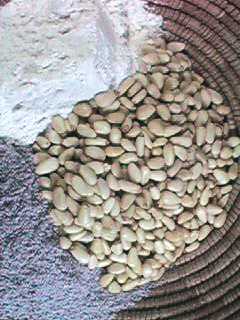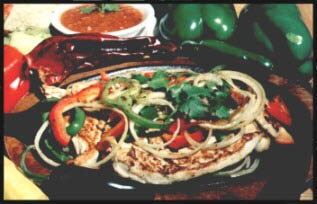New Mexico Cooking
|
Besides a preference for green chile, there are other things that
make New Mexican cooking unique. A blend of Mexican and local Native
cuisine, New Mexican food is not only tasty, but generally low in fat
and calories.
You'll find the usual Mexican fajitas, enchiladas and burritos
here - but the burrito is likely to be stuffed with carne adovada (a
central NM specialty of pork stewed in red chile sauce), and the enchiladas
are served flat, not rolled!
Salsa rather than picante sauce is the general rule here, and rice
is seasoned and served on the side (not in your burrito - no black beans
or corn in burritos here, either) along with frijoles (refried beans).
Cheddar cheese is another NM staple included on many dishes.
Chile is far more than a seasoning - chile stew (red or green!)
is a standard here. Whole chiles are made into rellenos (stuffed with
jack cheese, breaded, and deep fried, mm mm good!) and served as a main
course.
Native dishes like posole (corn hominy stewed with chile), chile
stew and corn pudding are staples of New Mexican cooking. Blue corn,
the prize grain of the Pueblo tribes, is made into pancakes, muffins,
cornbread, chips, tortillas, and more. Pumpkins and other squash, and
pinto beans, are also important features of NM cuisine.
And then there is the ubiquitous Navajo taco, without which no
New Mexico gathering can occur. To tell you the truth, I have no idea
if it's really a Navajo thing or not, because everybody eats them. But
no fair, rodeo, special event, outdoor concert, etc., is complete without
large crowds of people trying to balance enormous piles of food on slabs
of frybread and take bites from it without spilling it all over themselves,
each other, or the ground. Even sitting down with both hands free this is
not an easy task, but the mark of a true New Mexican is the ability to do
it on the move while dodging other taco-eaters, with your hands full of everything
else you have to carry. Watching the "taco games" is one of my favorite entertainments
at the State Fair.
Nuts from the pinon trees are added to salads and other dishes, and
are delicious when roasted and added to coffee. Mesquite wood adds a wonderful
flavor to grilled meats. Cacti, too, find their
way onto the menu here: prickly pears are made into delicious jellies,
chutneys, salsas, and rellenos or can be added to a salad.
All these things combine to form a flavor that is uniquely New Mexican!
(PS - if you're looking for some "chili" while you're here - that
stuf with the ground beef and beans in it - you'll have to specify "tex-mex,"
otherwise you're likely to be served a bowl of green chile stew!)
|



|
|
|


